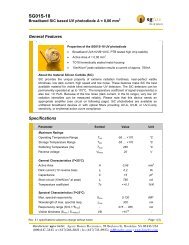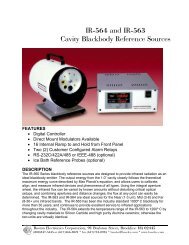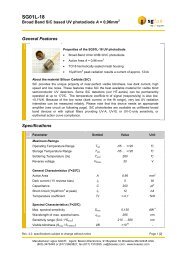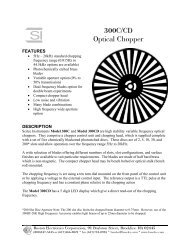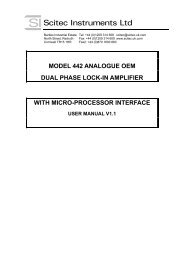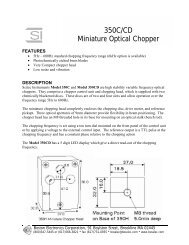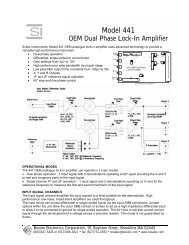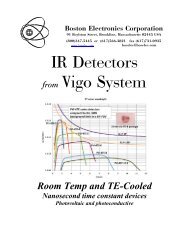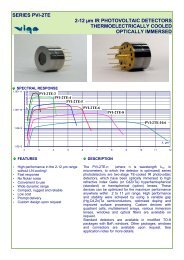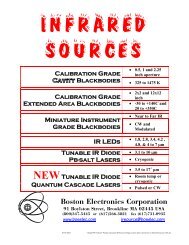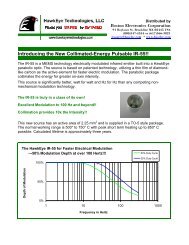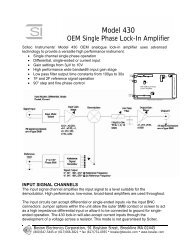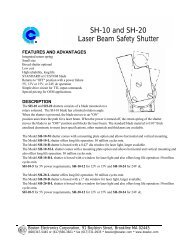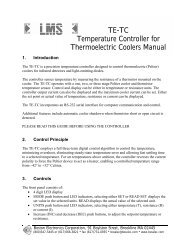TCSPC for FLIM and FRET in - Boston Electronics Corporation
TCSPC for FLIM and FRET in - Boston Electronics Corporation
TCSPC for FLIM and FRET in - Boston Electronics Corporation
Create successful ePaper yourself
Turn your PDF publications into a flip-book with our unique Google optimized e-Paper software.
different wavelengths. Each stack conta<strong>in</strong>s a number of images <strong>for</strong> subsequent times after theexcitation pulse.Fig. 37 shows a HEK 293 cell express<strong>in</strong>g a hybrid prote<strong>in</strong> <strong>in</strong> which the cyan (CFP) <strong>and</strong> yellow(YFP) shifted mutants of the green fluorescent prote<strong>in</strong> are l<strong>in</strong>ked together by a short am<strong>in</strong>o acidcha<strong>in</strong>. The setup used <strong>for</strong> this measurement [72a] consisted of a laser scann<strong>in</strong>g microscope(LSM-510, Zeiss), a polychromator (250is, Chromex), <strong>and</strong> a 16 channel <strong>TCSPC</strong> detector head [77]connected to an SPC-730 <strong>TCSPC</strong> imag<strong>in</strong>g module [63]. The setup recorded the wavelength rangefrom 410 nm to 635 nm <strong>in</strong> 16 wavelength channels, cover<strong>in</strong>g the emission b<strong>and</strong>s of CFP <strong>and</strong> YFP.The image below was obta<strong>in</strong>ed by summ<strong>in</strong>g the photons from all time channels of the CFPfluorescence.CFPFig. 37: HEK 293 cell express<strong>in</strong>g a CFP-YFP hybrid prote<strong>in</strong>Left: Intensity image of CFP. Right: Fluorescence decay curves of CFP <strong>and</strong> YFP <strong>in</strong> a selected region (square).Fluorescence decay analysis <strong>in</strong> a selected region (small square) reveals a double-exponential decayboth <strong>for</strong> CFP <strong>and</strong> YFP. The <strong>in</strong>tensity coefficient of the fast component is positive <strong>for</strong> CFP <strong>and</strong>negative <strong>for</strong> YFP, <strong>in</strong>dicat<strong>in</strong>g that energy is transferred from CFP to YFP. In Fig. 38 the <strong>in</strong>tensity isrepresented by the brightness, the ratio of the coefficients by the colour of a pixel. The results areshown <strong>for</strong> the CFP <strong>and</strong> the YFP fluorescence.CFPYFP0.400.80-0.65 -0.15Fig. 38: <strong>FRET</strong> images <strong>for</strong> CFP (left) <strong>and</strong> YFP (right) of a HEK cell express<strong>in</strong>g a hybrid prote<strong>in</strong> <strong>in</strong> which CFP <strong>and</strong> YFP are l<strong>in</strong>kedtogether by a short peptide. The brightness represents the <strong>in</strong>tensity, the colour the ratio of the amplitudes of the fast <strong>and</strong> slow decaycomponents. From [72a]31



